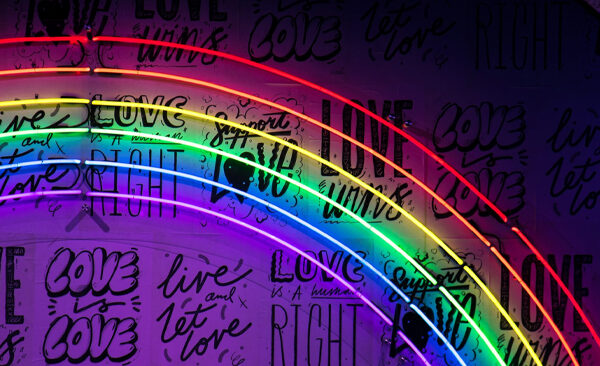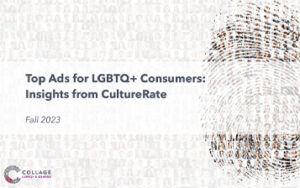Top Ads for LGBTQ+ Consumers: Insights from CultureRate

Learn how brands effectively engage diverse Americans with culturally fluent advertising. Use this research to decode the art of connecting with the LGBTQ+ community while minimizing potential backlash from other segments.
Brands increasingly try to embrace and reflect America’s diversity, yet many tread carefully when supporting the LGBTQ+ community, wary of potential backlash. In the July 2023 CultureRate:Ad study, Collage Group tested nine high-profile commercials and brand activations to gauge their appeal to LGBTQ+ viewers and other consumer groups. These ads span different industries and cover a breadth of LGBTQ+ topics: from broad representation to specific areas like transgender athletes’ rights and mental health concerns in LGBTQ+ youth.
Fill out the form to download an excerpt from Top Ads for LGBTQ+ Consumers: Insights from CultureRate and read below for all the latest insights on this segment.

Using Collage Group’s proprietary CultureRate:Ad methodology, we evaluate the impact of each activation by gauging both positive and negative reactions from LGBTQ+ and non-LGBTQ+ consumers, as well as those who express Liberal and Conservative political views. We also compare these ads’ effectiveness to the CultureRate norms, derived from the analysis of 126 ads tested between February 2022 and July 2023.
What surprised us:
There wasn’t one, homogenous response to LGBTQ+-inclusive ads from self-described Conservative consumers. While some expressed strong reservations or even backlash, many agreed that some of the ads conveyed messages that were important to tell.
Why it matters:
Mental health coverage is top-of-mind for Americans when considering health insurance, so creating easily accessible and straightforward resources that explain your brand’s mental health coverage is crucial to bridge the knowledge gap.
The Big Picture: Ground Your LGBTQ+ Advertising in Culturally Nuanced Insights to Drive Resonance and Mitigate Backlash
- Real backlash against LGBTQ-focused ads is limited — even among the greatest critics. However, consumer annoyance, which gets further amplified in public discourse, warrants a proactive mitigation strategy.
- Many LGBTQ+ Americans suspect brands’ attempts to appeal to them through ads are insincere. Executions that lack depth, practical impact, or brand fit are deemed performative and fail to resonate even with the intended audience.
Key Takeaways from Highly Resonant Ads
- PetSmart’s “You Are Loved” is a safer bet that wins over the intended audience and minimizes backlash. The ad uses the language of universal bonds between pets and humans to make its pointed message of true unconditional love more relatable and palatable to broader audiences. The ad boosts brand performance with the LGBTQ+ segment and maintains pre-ad levels for everyone else. Notably, more than half of Conservatives believe in the importance of the ad’s Message.
- Adidas’s “Impossible Is Nothing” is a strong message of intersectional inclusion that creates cascading Halo Effects. It celebrates the power and poise of women, including transgender athletes, and fluently reinterprets its renowned tagline to win over diverse women while retaining men’s favor. Backlash levels approach but don’t cross the level of significance above the norm.
- LEGO’s “A to Z of Awesome” speaks boldly on gender and sexual identity to appeal to the LGBTQ+ segment and beyond. Staying true to the brand’s core values of joy, creativity, and caring lends further legitimacy to the ad. The ad boosts LGBTQ+ people’s Brand Favorability and Purchase Intent and only causes minor dips for others, a remarkable feat given the polarizing topic.
A Cautionary Tale of an Activation that Fell Short
- Bud Light’s partnership with Dylan Mulvaney lacks brand fit and is deemed performative, especially by its intended audience. It weaves the right themes that typically resonate with LGBTQ+ consumers, but the brand lacks permission to play. The activation didn’t meaningfully affect Brand Favorability or Purchase Intent, which were already relatively low.
Contact us today learn how you can partner with us on the journey to cultural fluency and engaging diverse America.